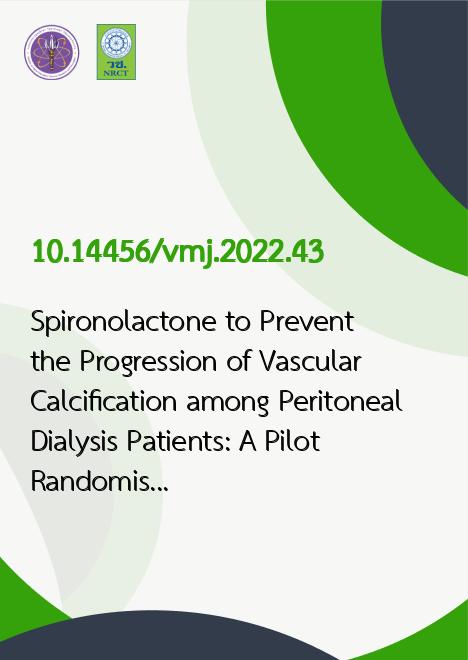
|
Spironolactone to Prevent the Progression of Vascular Calcification among Peritoneal Dialysis Patients: A Pilot Randomised Controlled Trial (SV-CAPD trial) |
|---|---|
| รหัสดีโอไอ | |
| Creator | 1. Peerapat Thanapongsatorn 2. Solos Jaturapisanukul 3. Torpong Claimon 4. Surazee Prommool |
| Title | Spironolactone to Prevent the Progression of Vascular Calcification among Peritoneal Dialysis Patients: A Pilot Randomised Controlled Trial (SV-CAPD trial) |
| Publisher | Text and Journal Publication |
| Publication Year | 2565 |
| Journal Title | Vajira Medical Journal |
| Journal Vol. | 66 |
| Journal No. | 6 |
| Page no. | 415-426 |
| Keyword | coronary artery calcium score, peritoneal dialysis, vascular calcification, spironolactone |
| URL Website | https://tci-thaijo.org/index.php/VMED |
| Website title | Vajira Medical Journal (วชิรเวชสาร) |
| ISSN | 0125-1252 |
| Abstract | Objective: The purpose of the study was to investigate the efficacy and safety of spironolactone to prevent vascular calcification among peritoneal dialysis patients. Methods: This study was a randomised, double-blinded placebo-controlled trial conducted from August 2018 to December 2020 at Vajira Hospital, Thailand. We randomly assigned peritoneal dialysis patients to receive either 25 mg of spironolactone daily or a placebo for 6 months. Coronary artery calcium scores and laboratory tests were performed and compared at baseline, and 6 months thereafter. Results: Among the 40 patients initially randomised, 34 patients completed the study (17 patients in the spironolactone group and 17 patients in the placebo group). There was no difference in baseline characteristics or laboratory results between both groups. The spironolactone group showed a significant reduction in CACs at 6 months (169.97 AU [IQR 2.34 - 1146.29] to 92.29 AU [IQR 4.83 - 851.1], p=0.05). Compared to placebo, spironolactone had a lower percentage change in CACs (0% [IQR -47.1-14.7] vs 6.06% [IQR -1.9-40.8], p=0.07. However, the change in the absolute progression of CACs was not different (0 AU [IQR -30.5-58.3] in the spironolactone group vs 6.14 AU [IQR -13.9-331.2] in the placebo group). Spironolactone also showed significantly lower serum phosphorus and osteocalcin (3.8 ? 1.3 mg/dL vs 4.8 ? 1.1 mg/dL and 69.0 ng/mL [IQR 41.9-151.5] vs 178.0 ng/mL [IQR 86.8-269.5], p=0.02 and 0.014, respectively). No hyperkalaemia or hypotension was found in either group. Conclusion: Among peritoneal dialysis patients, spironolactone showed a potential benefit to prevent the progression of vascular calcification. Further studies with a larger population and long-term follow-up should be conducted. |